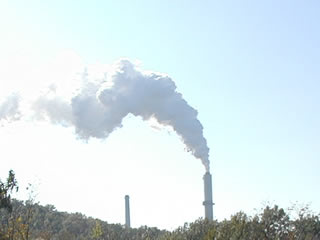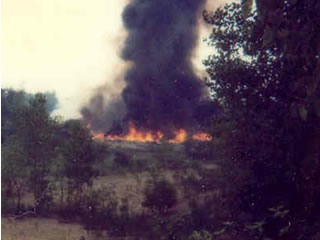|
 Air
Pollution Air
Pollution
Air pollution is the presence of “one or
more chemicals in high enough concentrations in the air to
harm humans, other animals, vegetation, or materials”
(Miller G1).
Air pollution comes from many different sources,
such as motor vehicles, industry, small businesses, farming,
and everyday products like cleaning solutions, paints, thinners,
and lawn and garden equipment. Cars and trucks release carbon
monoxide, nitrogen oxides, particulate matter, and air toxins
into the atmosphere. In 2000, it was calculated that every
Hoosier over the age of eighteen drove an average of forty-three
miles a day, every day. Automobiles are one of the major causes
of air pollution in Indiana.
Another problem area in Indiana is the release
of dangerous ozone. There are two major types of ozone. “Good”
ozone resides in the upper atmosphere and protects us from
the sun’s harmful ultraviolet radiation. “Bad”
ozone is ground-level, and can cause health problems such
as increased respiratory problems, coughing, nausea, and chest
pain. Bad ozone is formed by certain pollutants that are directly
related to air pollution, such as gasoline vapors from automobiles,
chemical solvents, and the burning of fuels such as coal,
oil, or wood. Currently, twenty Indiana counties are at risk
of not meeting the existing ozone standards.
 Photo
by Dean Smith
Photo
by Dean Smith |
Air
pollution from plastic burning |
The problems of air pollution in Indiana became
evident during the Industrial Revolution, when factories began
emitting large amounts of dangerous toxins into the air, through
the burning of coal for energy. According to the Encyclopedia
of Sustainable Development, "The burning of fossil
fuels led to a massive increase in urban air pollution although
most people felt that such a disadvantage was not significant
in the context of their new found prosperity" (aric).
Coal usage today is cleaner than in the Industrial Revolution
because of new standards for coal burning. The state of Indiana
has implemented "clean coal technology." This technology
is classified as such because it decreases the amount of pollutants
released into the air by the combustion of coal. The state
offers incentives to companies who use clean coal technology,
such as funding and grants for alternate energy research.
Over the past ten years, Indiana’s air
has become considerably cleaner, but there are still areas
of concern that need to be improved upon. The use of vehicles
is still a major cause of air pollution, as is coal burning.
While laws dealing with air pollution are becoming more stringent,
the quality of air rises.
Sources:
"Fossil Fuels." Encyclopedia
of Sustainable Development. 2002. Atmospheric Research
& Information Centre. 27 June 2004 <http://www.ace.mmu.ac.uk/esd>
.
"Industrial Revolution"
Encyclopedia of Sustainable Development. 2002. Atmospheric
Research & Information Centre. 27 June 2004 <http://www.ace.mmu.ac.uk/esd>.
Miller, G. Tyler. Environmental
Science: Working with the Earth. 8th edition. Australia:
Brooks/Cole, 2001.
State of Indiana. Department of Environmental
Management. "Air Quality." 2002 State of the
Environment Report. 2002. 16 Oct. 2002 <http://www.in.gov/idem/soe2002/air/>.
State of Indiana. Indiana General
Assembly. "Clean Coal Technology" Indiana Code,
title 8, article 1, chap 8.7. 2002. 20 Nov. 2002. <http://www.in.gov/legislative/ic/code/title8/ar1/
ch8.7.html>.
---. "Utility Generation and
Clean Coal Technology." Indiana Code, title
8, article 1, chap 8.8. 2002. 20 Nov. 2002 <http://www.in.gov/legislative/ic/code/title8/ar1/ch8.8.html>.
|




